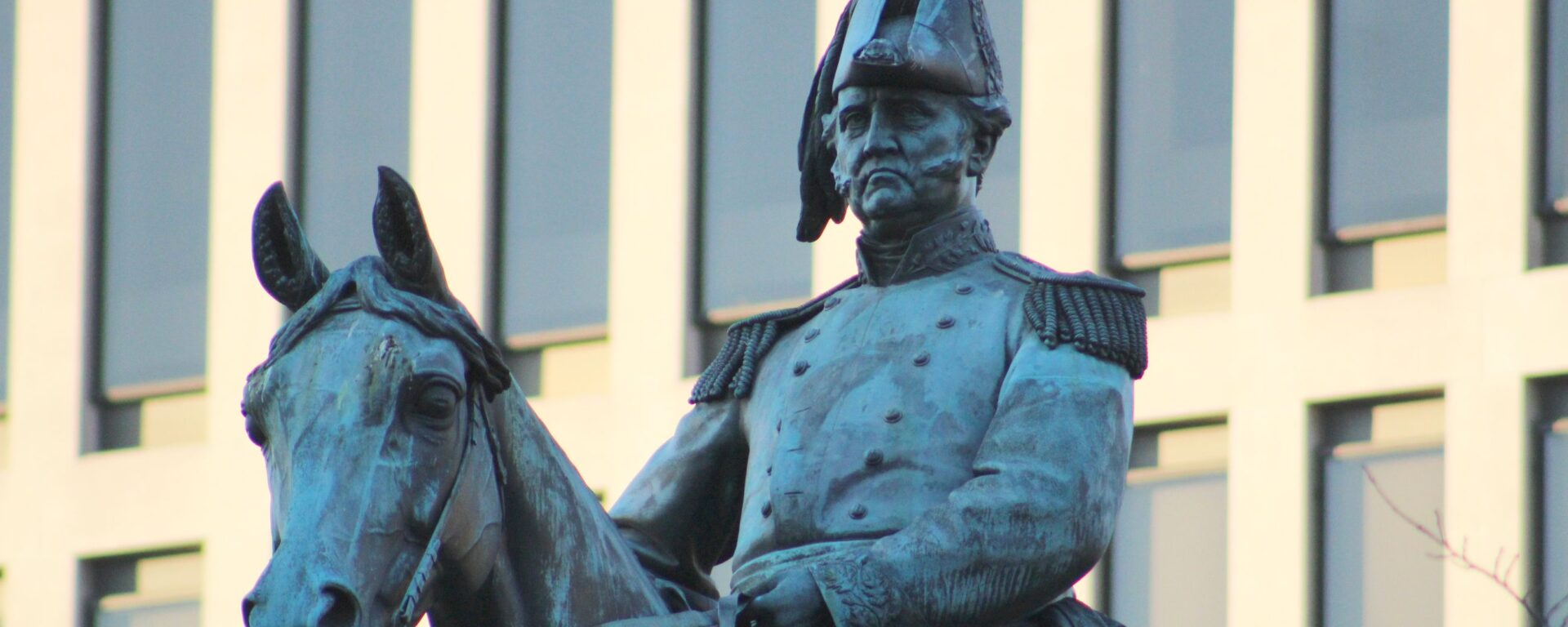“Peace won by compromise is usually a short lived achievement.”
Scott Circle sits at the intersection of 16th St. NW, Massachusetts Ave., and Rhode Island Ave. To the east is the Samuel Hahnemann monument and to the west is Daniel Webster’s monument. Thousands pass by it daily, though few know of the contributions of General Winfield Scott (or his legacy), whose equestrian statue stands in its center.

No official ceremony marked the erection of the monument, but it was greeted with some criticism. Scott preferred to ride mares instead of stallions, so the sculptor, Henry Kirke Brown, had him astride a mare. Scott’s family protested this decision and insisted that he be riding a stallion, so Brown nominally accommodated the family by adding male parts to the horse while retaining the smaller frame of a mare. But Scott was a large man – he was the tallest man to ever run for president – and his portly frame on the slender body of a mare made the statue seem out of proportion. Upon seeing it, General Philip Sheridan is reported to have asked his wife to never allow a statue of him to be built like Scott’s.
Scott’s statue was the first in the city to honor a Civil War general. The base of the statue rises 30 feet and is carved from a single block of granite, the largest ever quarried at the time. The statue rises another 10 feet above the base, facing south towards the White House. Scott’s left hand is holding the reins of his horse. His right is at his hip, holding a pair of binoculars. The total cost of the monument was $77,000. The bronze for the statue came from cannon captured by Scott during the Mexican-American War.

Winfield Scott began his service to the United States in 1808 when he was 21. He quickly gained his life-long nickname “Old Fuss and Feathers” for insisting on military bearing and discipline at a time when the army was largely made up of militia and volunteers. His focus on discipline would serve him well in the War of 1812, where he was quickly promoted to brigadier general. Due to his constant training, he was able to hold his own against the British army at the Battle of Chippawa and the Battle of Lundy’s Lane. These battles established the reputation of American soldiers as “professionals” around the world.

Besides his arrogance and his ambition, the greatest stain on Scott’s name came in the next chapter of his life. In 1836 he briefly commanded the army forces in the Seminole Wars and in 1838 he was put in charge of the removal of Cherokee from the southeast to the Indian Territories in what is now Oklahoma. Although Scott’s intentions were to execute his orders with humanity, the reality was much different. He rounded up all of the Cherokee into what were essentially internment camps where thousands died before the deadly, forced march west even began. Private John G. Burnett would write years later, “Future generations will read and condemn the act and I do hope posterity will remember that private soldiers like myself, and like the four Cherokees who were forced by General Scott to shoot an Indian Chief and his children, had to execute the orders of our superiors. We had no choice in the matter.” The forced Cherokee removal is now known as the Trail of Tears.
In 1846 the United States entered into war with Mexico, and it is here that Scott would write his name in the annals of history. The war began as a land dispute, but Mexico was not prepared for war and soon lost much of its northern territory to future president Zachary Taylor. Scott was tasked with capturing Mexico City and definitively ending the war. He landed at Veracruz in March 1847 and quickly outmaneuvered the numerically superior Mexican army in a series of decisive battles. By September he had captured their capitol and ensured a U.S. victory. Under his command during this campaign were future president Ulysses S. Grant and future Confederate generals George Pickett, James Longstreet, Thomas (Stonewall) Jackson, and Robert E. Lee.

General Winfield Scott was considered the greatest general of his time by none other than the Duke of Wellington, the man who defeated Napoleon at Waterloo. He is the longest-serving general in United States history as well as the longest-serving Commanding General of the Army. He served under every president from Thomas Jefferson to Abraham Lincoln. In the early days of the Civil War he devised the plan that would eventually be used to defeat the Confederates. He was the first person since George Washington to achieve the rank of lieutenant general (although it was a brevet, or honorary, promotion) and the first general since Washington to appear on U.S. postage. Numerous towns and counties bear his name across the country. Though forgotten today in popular history, his legacy is an indelible part of the nation.

Resources used for this article:
https://en.wikipedia.org/wiki/Winfield_Scott
https://en.wikipedia.org/wiki/Brevet_Lt._General_Winfield_Scott
https://en.wikipedia.org/wiki/Henry_Kirke_Brown



One thought on “Brevet Lt. General Winfield Scott”
Comments are closed.